Cannes - bright beautiful garden flowers, adorning summer cottages from the middle of summer to autumn. Red, yellow, motley, white, bright orange large flowers attract attention and look very smart and effectively. Cannes - the favorite of landscape designers and polivities that use a flower for decorating lawns, flower, and household plots. Cannes look great both in a single landing, and in a group with other flowers and plants, giving the composition a lot of charm.
Cannes: Description
Canna (Canna) - a perennial herbaceous plant, the only representative of the Cannes family. In the wild there are more than 50 different varieties and types of Cannes, which grow in warm climatic conditions of countries such as India, Africa, Indonesia, as well as in South America's tropics. The habitats of Cannes - the shores of rivers, streams, in areas with a moisturized ground.
The luxurious flower has a reprehension of thin unreasonable stems, reaching heights from 80 cm to 2 meters, separate species grow up to 3 meters in height. Plant leaves are large, lanceal or oblong shape, can grow up to 80 cm long, up to 25 cm wide. Cane leaf color can be bright green, and reddish-bronze, and striped, depends on the variety of plants. Leaves thick cover the stem and look very attractive. Due to the number of leaves in the stem, Cannes is called a "miniature palm". Some types of Cannes Landscape designers are used due to leaves decorative.
But, nevertheless, all its magnificence canna reveals during flowering. Cannes flowers on the flowers are arranged asymmetrically, collected in inflorescence in the form of a brush or pan. Have an external similarity with gladiolus. The main color of Cannes flowers is rich red, the selection path managed to remove the varieties with bright yellow, pink, white and two-color petals. Cannes Flowers do not exude a fragrance, which is their distinctive feature. Tropical beauty in the garden is an ideal plant for people suffering from allergies or those who poorly carry sharp odors of colors. The beginning of flowering - July, lasts until late autumn.
After flowering, the fruit is formed - a three-traveleled box of oval or cylindrical shape with round black seeds located in two rows, the ripening time of fruits is from 30 to 40 days.
The plant has a powerful branching root system, smashes into width. Cannes is actively growing even in poor, non-fermentation soils.
Cannes: varieties and varieties
Among the huge variety of species and varieties of Cannes, each of which is unique with its shape, color of petals and leaves. Cannes Indian is the first garden hybrid, which brought the French cero breeder. Based on its starting material as a result of many years of selection, many varieties of plants were derived, which have the common name "Cannes Sadovaya". Allocate 3 main groups of Cannes Sadovaya:
- Deciduous (small-bedal) Cannes. The highest canna, which reaches up to 3 meters in height. Leaves at the plant - large dark green with a purple tint, flowers are small, about 6 cm.
- Cannes Corrosive. Low cannes, outdoor resemble large gladiolus. Reach height from 70 cm to 1.5 meters. Flowers -rupny, about 10 cm, green leaves, purple with a sizh ripple.
- Cannes orchidoidal. This group includes cannes of medium height, up to 2 meters. Leaves - fleshy, green, flowers are large, resemble a large orchid flower, have a bright two-color color.
Popular varieties of Cannes
- Andenken An Pfitzer. Cannes orchidoidal up to 1.5 meters high, blooms luxurious bright orange flowers with purple splashes on petals. The leaves are painted in green with a brown tint.
- R. Wallase. Cannes reaches a height of about 1 m, blooms with light yellow flowers with crane splashes. The leaves are green, the variety is not fruit.
- Durban. Small-color canna with small yellow-orange flowers and striped leaves, which are the main decoration of the variety. The shade of leaves can be pink, bronze, yellow-green.
- Livadia. Cannes with a height of about 1 meter with red-raspberry flowers, which are effectively shaking purple leaves.
- Amerika. Reaches a height to 1.5 meters, flowers with red large flowers up to 12 cm in diameter. Dark purple leaves look very decorative.
- Clara Bulsson. Plant height up to 1.2 meters, blooms orange-red flowers, purple leaves.
- Louis Kayeux. Cannes height from 1 to 1.3 meters with gentle pink flowers and green leaves.
How to grow kannan in spring
Luxurious Cannes look equally impressive on the household plot, and in a pot grown at home. Frequently low varieties of cannes are planted in vases, hubs, big pots on balconies in greenhouses. Evergreen tropical plant - bright decoration of the winter garden.
Many novice flowers fear to land Cannes into open ground, considering it a capricious tropical guest, very demanding to care. Growing Cannes in the garden is quite simple. It is enough to know the features of its cultivation, landing rules and provide the plant the necessary agrotechnical care, as in the natural environment of its habitat in the wild.
Place for planting Cannes in spring
Cannes - a native of warm countries with a wet climate, so when choosing a place in the garden, it must be considered preferences. The place where you plant a plant should be well lit and not shaded. In the shade of trees or household buildings, Cannes will not grow. Another important condition for its cultivation is a reliable protection against strong wind or draft. An excellent option is to plant a plant at the wall of the house, which will protect it from the wind. Cannes decorative plant, so it is worth choosing for its landing the most prominent place in the garden. Using a spectacular canow to create flower compositions, as the neighbors for it, pick up shapeless plants, since the magnificent foliage of the plant can close other plants access to the light.
How to propagate canow for planting in spring
Cannes for landing breed in two ways:
- Vegetative: reproduction of rhizomes.
For the reproduction of the plant in a vegetative way, the fission of rhizomes is applied. Using this method of reproduction, next summer you will receive a flowering plant. In the last days of September, Cannes must neatly dig together with a small lounge of land, trying not to damage the rhizome. Dipped rhizome flower is placed in a dark and cool place. It is necessary regularly throughout the winter season to conduct its inspection, make sure that the roots do not start.
With the onset of spring, at the end of March, the rhizome is divided into parts. It is necessary to divide it so that one or two strong kidneys are on each part of the root of the root, which will give rise to a young plant. The slice location should be processed with crowded activated coal and add, for disinfection. Then the decens, kidney up are placed in a capacitance with sawdust or with landcase consisting of peat, sand and black soil in equal parts, and topped with sand. Dellek containers need to be placed in a warm place (from 20 to 24 degrees) to germinate seedlings. Periodically, the decene should be moisturized and not to allow them to dry.

After the appearance of sprouts, which grow pretty quickly, the seedlings are transplanted into small pots and put them in a cooler and bright room (about 16 degrees).
- Vegetative: reproduction of seeds. The seed method of reproduction is less common than vegetative. The most optimal term for seeding seeds is the beginning of February.
The most important condition at the seed method of breeding Cannes is preliminary training of seeds, which contributes to their rapid germination, within a month.
Preparation of Cannes Seeds to Landing Spring
- Cannes seeds have a very dense shell. At first it needs to be scolded with boiling water, and then placed under the stream of cold water.
- After water procedures, the seeds are placed in a thermos with warm water for swelling.
- Conduct mechanical damage to the shell, for example, to lose seeds with river sand or make small cuts.
- Seed prepared for landing plant in the ground. For sowing seeds, you can use a universal soil for indoor plants or prepare a soil consisting of two parts of reworked foliage with peat, pieces of turf and 0.5 parts of river sand.
- Capacities with canine seeds must be at a temperature of about + 25 ° C. After the appearance of 2 leaves, seedlings need to dive into separate small pots.
To landing in the open soil seedlings is ready in May, early June.
Spring cannes landing
Planting young plants is carried out in the spring, closer to the second half of May, when the threat of frosts.
Selection of soil for planting Cannes in spring
Soil for planting Cannes should be fertile, loose, deeply processed. The ideal composition of the soil: one-third of coarse sand, peat and leaf land. To ensure the colors of the magnificent long flowering, experienced flowers are recommended before planting, in the spring to create a plant warming litter from manure. To make it, it is necessary to dig a hole with a depth of 70 cm, pour into it a layer of horse manure (about 20 cm) and from above sprinkle with soil. Twisting, manure will create a warm medium for rhizomes of the plant, also supports the soil for active growth and abundant flowering.
How to plant Cannes in spring in open ground
In the open ground, Cannes is planted in a hole in a depth of 15 - 20 cm, observing the distance between at least 50 cm. The root neck must be deepened into the ground for 2 cm and slightly tamme the soil. After planting, young plants need abundant irrigation, at least 5-10 liters per bush. Water for watering uses warm, about 25 degrees.
Cannes Spring: Care
Beauty Cannes, like any plant, requires care. So that the flowering is long and abundant, the plant needs to be delivered in a timely manner from weeds, loosen the ground around the bushes, remove the blurred inflorescences, maintain the constant humidity of the soil and make the necessary fertilizers.
Watering Cannes
Cannes - natives of countries with a wet climate, so the soil around the bush should be moderately moistened. During the flowering period, watering increases, but it is impossible to fill the Cannes. Excessive soil moisture provokes the development of fungal diseases and blackening buds - Cannes will not bloom. In the fall, after gradually focusing, irrigation volumes are reduced.
Loosening and enclosure cann
Flowers and garden sites where Cannes grow, it is necessary to regularly gour out and remove weeds to ensure the air permeability of the soil.
In autumn, when the air temperature decreases significantly, Cannes are highly plunged to protect the root neck of the plant. Low temperature is detrimental for the southern plant. In October, before the onset of the first frosts of the root, along with a lump of land, they dig and store the winter period until spring in the cool room.
Caring for Cannes during flowering
Distinctive feature of Cannes - long abundant blossom from mid-summer until October. In order for Cannes to bloop the whole season, experienced flowers are recommended to periodically cut the flowers to not give to the seeds. Zagazi impede the formation of new flower buds. Cut flower with a secateur or sharp knife. Cut flowers look spectacularly as in a single bouquet, so in compositions with other garden flowers. Cannes stand in water from 4 to 8 days.
If you notice that Cannes do not bloom for a long time, it is worth watching the lighting of the plant during the day. The cause of its reluctance to bloom, there may be a lack of sunlight from the shade of trees, hedges, economic construction.
Undercotter Cannes
To achieve long and lush flowering Cannes, it needs to be made regular feeding with mineral and organic fertilizers.
- It is necessary to fertilize the ground chicken litter, clumsy in the water in the proportions of 1:10. Just one watering fertilizer in two weeks. Under one bush is consumed with 0.5 liters of liquid fertilizer.
- During the vegetation of Cannes, the mineral fertilizers feed: a mixture of potash, nitrogen and phosphoric fertilizers in the proportion of 10:12:25 g per square meter of the site. The granules scatter around the landed cann after watering, then the soil should be exploded.
- During the formation of buds, fade by piled wood coal.
How to keep rhizomes in winter
After flowering, at the end of September or early October, Cannes need to dig up and move them along with a lump of land into a cool room where they should be stored until spring. Room for wintering cannon should be not only cool, but also with moderate humidity. Rhizomes are laying out in boxes or containers and peat, sawdust or sand. The temperature differences are not desirable.
Ideal storage conditions: air humidity -50%, and the temperature is from 6 to 8 degrees of heat.
It is necessary to regularly inspect the root. When revealed on it rot, the damaged section must be cut off, and the location of the cut is processed by iodine.
Cannes can also be stored in the refrigerator in the storage department of vegetables and fruits. In the fall, when tubers are dug, they are washed in running water and placed in a solution of mangartee for disinfection per day. Then dried. Each tuber wrapped in paper.
Knene rhizomes are perfectly winter in a conventional flower pot or bucket, powdered dry ground, on a glazed loggia or a balcony, where the air temperature is not higher than 15 degrees. In this case, the soil must be moisturized 2 times a month.
Diseases and pests cann
The main problem of Cannes is bacterial and fungal diseases.
Bacteriosis is subject to both the leaves and buds of the plant. In the first stage, white spots appear on the leaves, then the blackening and the death of buds occurs. The cause of bacteriosis is excessive humidity of the soil. The plant infected with bacteriosis is subject to destruction, since the disease is not treated. There is a likelihood of infection with other instances of the plant.
In addition to bacteriosis, Cannes are subject to such a disease as rustful fungus. It manifests itself in the form of yellowed leaves, which over time are covered with rusty spots. For prophylaxis from rust fungus, a solution of manganese (4 g must be divorced by 10 liters of water).
In rare cases, Cannes suffer from a polesaleling virus, in which the leaves of the plant are covered with small black dots. In the fight against the disease, the timely removal of damaged leaves and inflorescences is used.
Pests cann
Among the pests canned the caterpillars, eating leaves of plants and nematodes that feed on the roots of the plant. Insecticides are used to combat pests.
Cannes in landscape design
Cannes perfectly get along with any colors, the only condition is to take into account when planting flower, the rapid growth of the plant. High spectacular cannes can drown out the flowering of their more slowly growing neighbors.
Cannes looks great not only on the flowerbed, but also used as a waiting or pot plant for landscaping terraces, a veranda, balconies.
A massive bright flower can disguise or hide unaesthetic garden sections, household buildings. High cannes are often used in the form of a living hedge, and low-grade varieties are cleared along the garden tracks and borders. Cannes look unforgettable on the background of a bright green lawn, near the water branch, pond. 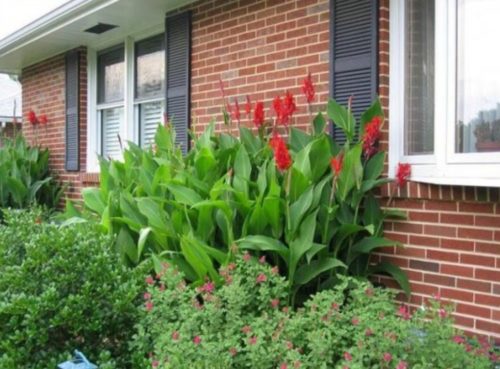
These bright flowers will delight you to deep autumn, decorating a sad autumn landscape with colorful blossoms.
Cannes, photos


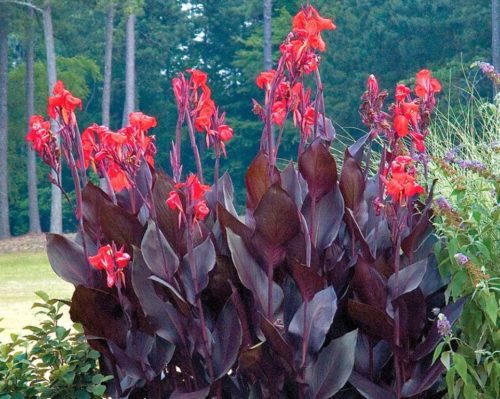
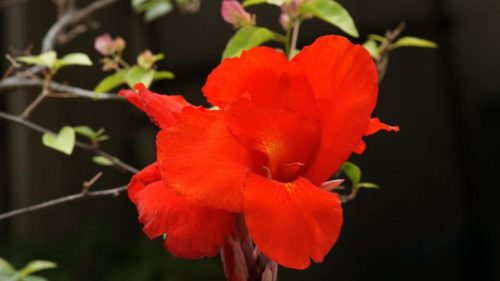
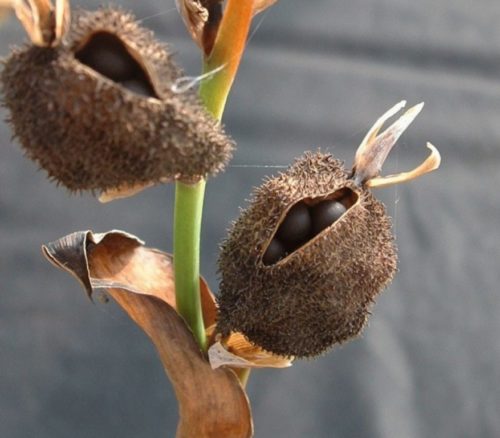
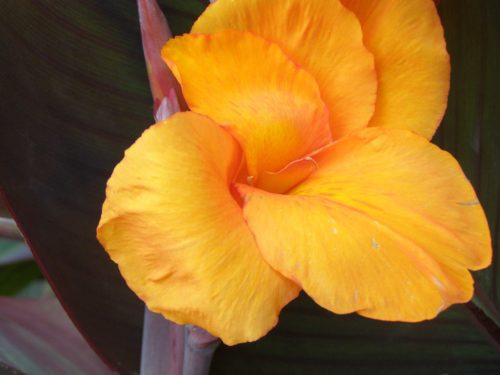

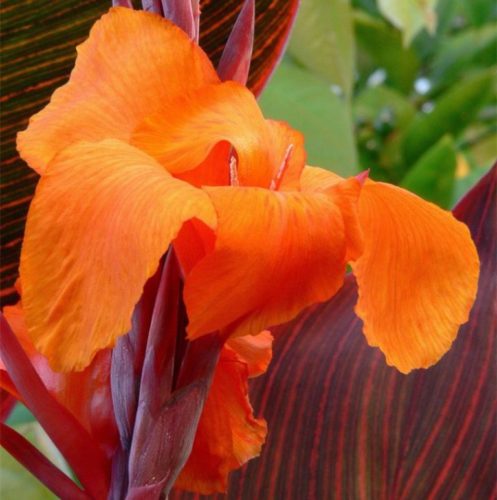
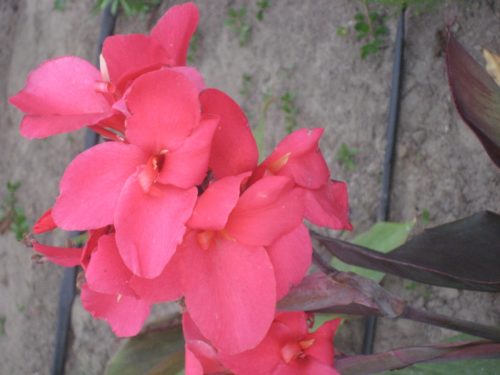
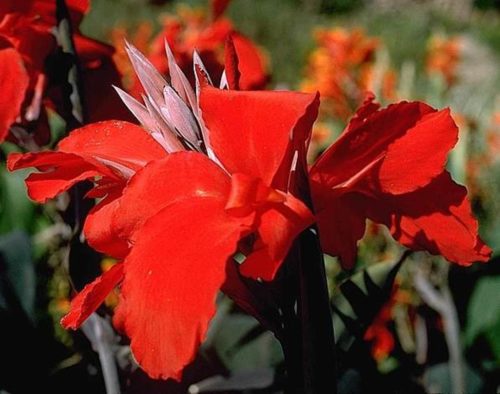
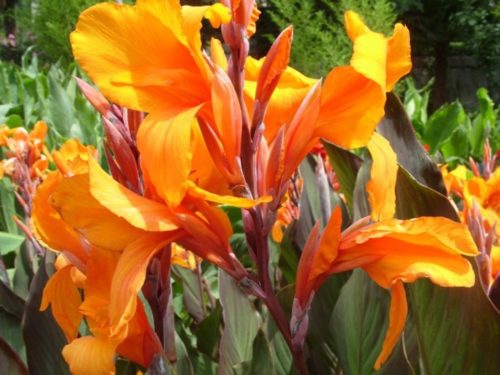
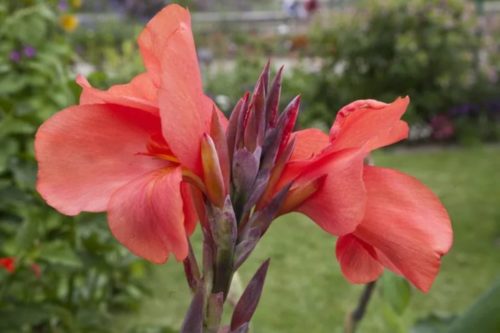
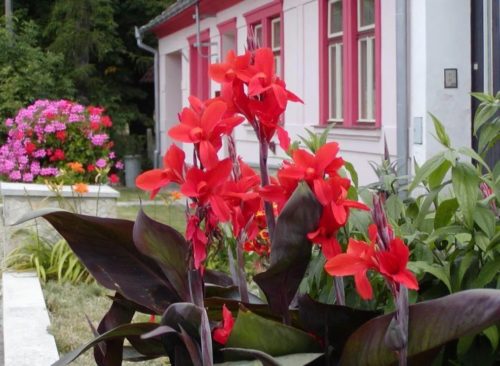
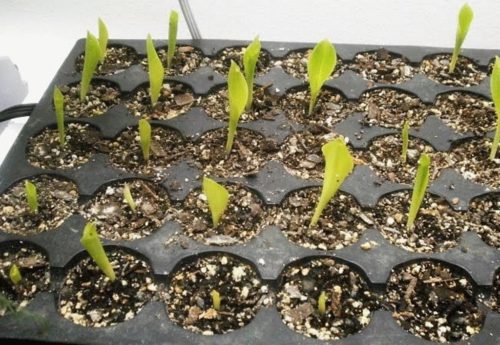

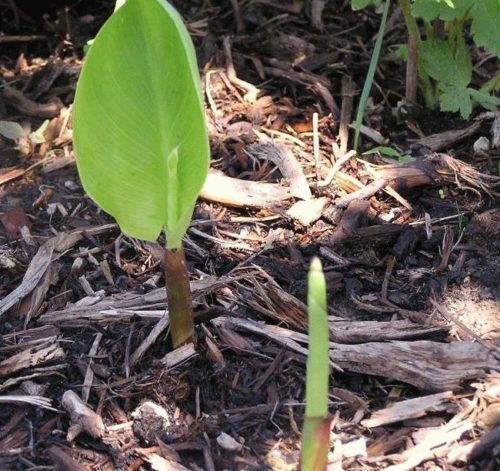
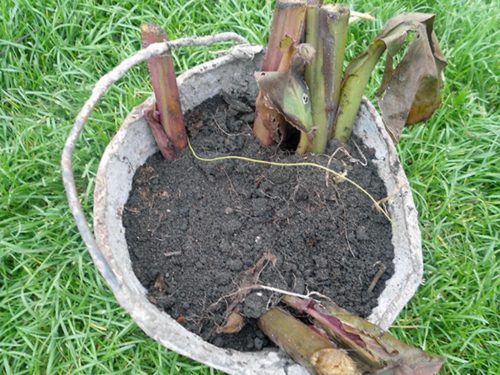
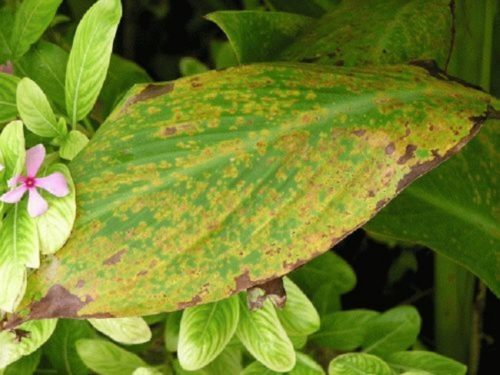
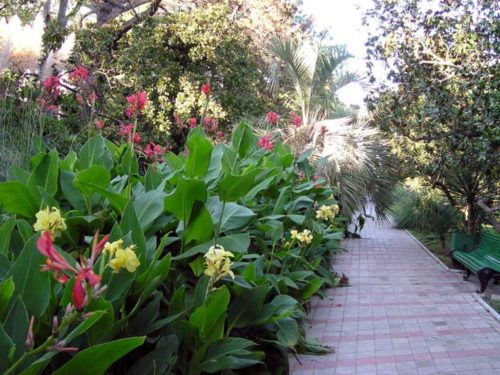
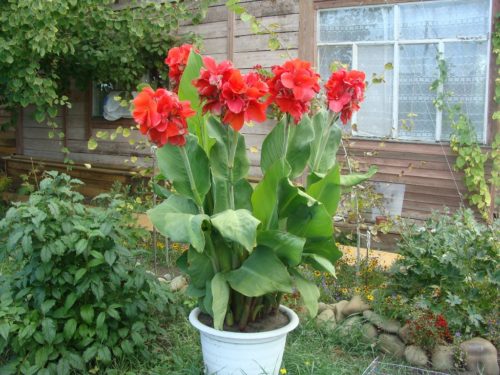
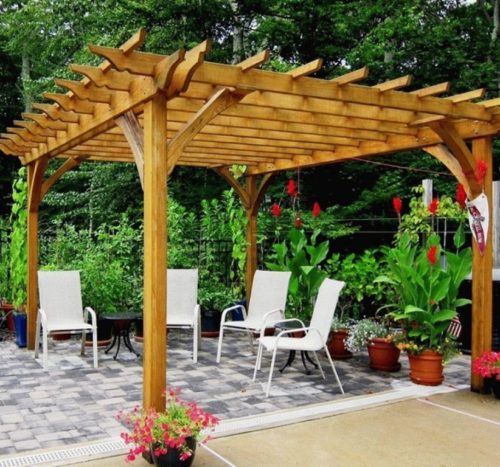
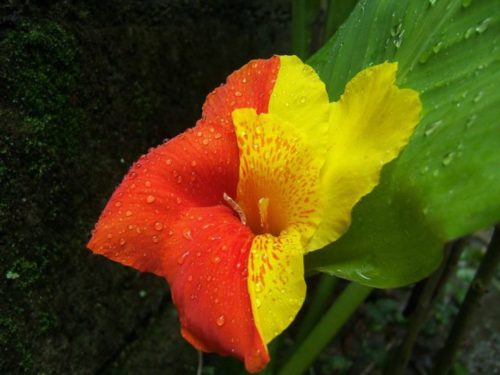
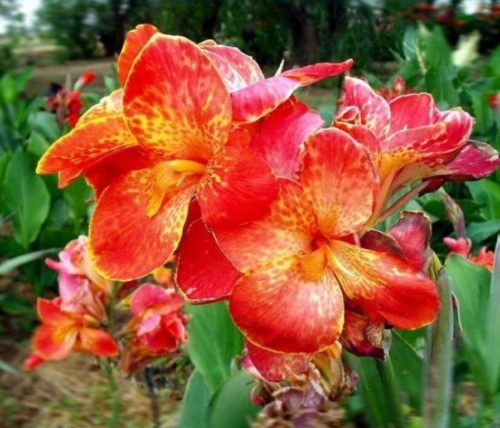
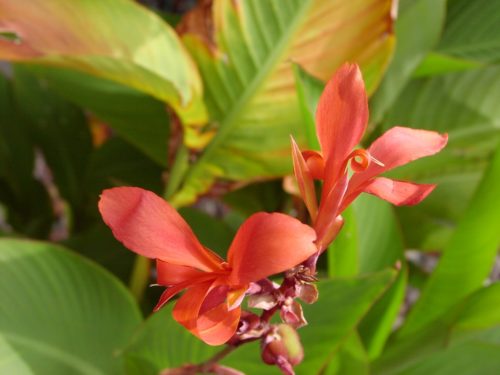
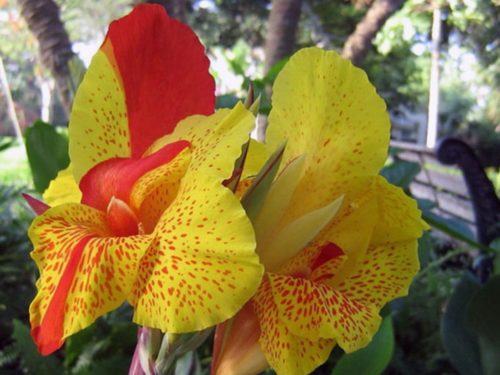












 Start a discussion ...
Start a discussion ...